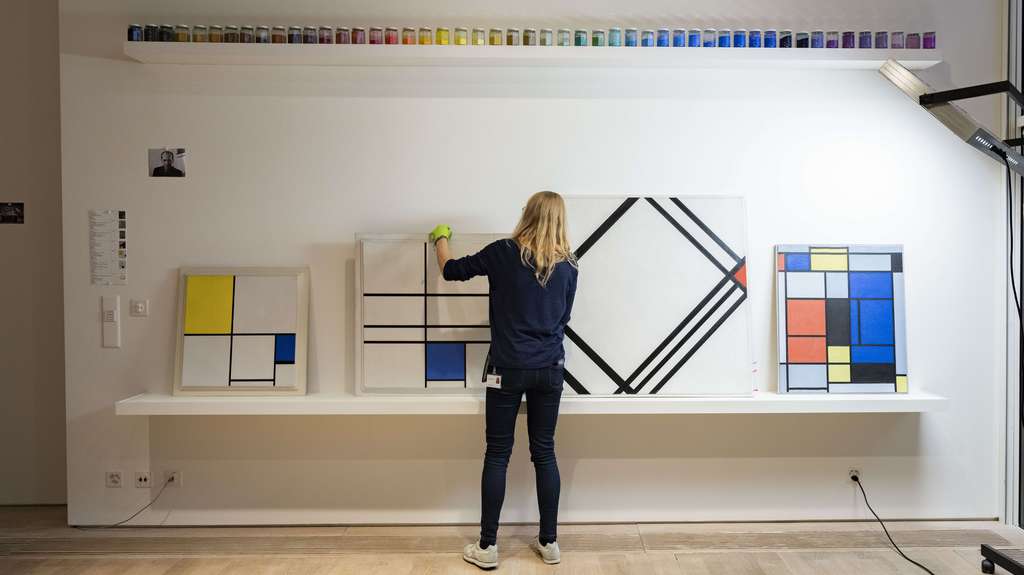Piet Mondrian, Composition with Double Line and Blue
Mondrian produced Composition with Double Line and Blue when he was living and working in his studio in the Rue du départ in Paris. There he was a member of the progressive artist groups Cercle et Carré (1929) and Abstraction-Création (1932).
In a letter of 1934, Piet Mondrian noted that he was seriously ill and that it was at times impossible for him to work. From his correspondence, we can also deduce that he had already made a start on Composition with Double Line and Blue this same year. In the first half of 1935, illness caught up with him once again, which meant that for a while he was unable to paint. The investigations by our conservation team have shown that the artist worked on Composition with Double Line and Blue over an extended period of time.
Mondrian – Drawer of Lines
“It is a great mistake to think that Neoplasticism constructs rectangular planes set side by side—like paving stones. The rectangular plane should be seen rather as the result of a plurality of straight lines in rectangular opposition.”
Piet Mondrian, “L’art réaliste et l’art superréaliste”, in: Cercle et Carré, 2, April 1930, n. pag. [p. 2]
The painting Composition with Double Line and Blue, like Composition with Yellow and Blue (1932), is one of Mondrian's Neoplasticist works, in which the artist concentrates on the rectangular arrangement of black lines with planes in white and the primary colors red, yellow, and blue. Between 1933 and 1936, Mondrian painted a series of pictures that resemble Composition with Double Line and Blueand feature double lines. In contrast to works of an earlier date, such as Tableau I (1921–1925), which are based on a grid drawn with a pencil and ruler, in the case of Composition with Double Line and Blue Mondrian seems to have worked intuitively. There is evidence to suggest that Mondrian wanted to express a kind of ‘balance’ in his compositions and so generate a certain ‘harmony’ in his paintings. He thereby sought an equilibrium between horizontal and vertical brushstrokes, as well as between the lines themselves, whereby the vertical lines are narrower than the horizontal ones. As from 1931, Mondrian began experimenting with narrower, double horizontal lines.
As has already been described in the case of earlier paintings, such as Composition No. VI, Mondrian began his working process with line, and more specifically with drawing the lines that characterize his Neoplasticist works. These line drawings did not need to take shape on paper, but could be developed directly on the primed canvas in charcoal or black oil paint. Even after Mondrian had begun painting the color planes, however, the process of line drawing did not end: between individual layers of paint, he regularly drew lines in order to refine his composition. This ongoing creative process is documented by historical photographs from Mondrian’s studio, as well as by the artist’s unfinished paintings.
Mondrian did not simply paint over discarded black lines, but fist wiped them off and scraped them away. In the case of finished paintings such as Composition with Double Line and Blue, subtle remnants of these lines can consequently only be detected with great difficulty, using a variety of imaging techniques.
Different imaging techniques yield different information: Composition with Double Line and Blue examined under visible light, raking light, transmitted light, UV fluorescence, incident IR, transmitted IR, and X-ray
Clues on the surface of the painting
With the aid of the microscope, it was possible to detect instances of residual traces of black paint in the depressions made by Mondrian’s brush on the surface of Composition with Double Line and Blue. Microanalyses revealed that the paint in question was the same black as used for the lines. Mondrian was thus working on the composition of the lines right up to the end.
Under a strong raking light from below, slight vertical lines can be recognized on the surface, suggesting further envisaged line constructs. A fine horizontal bulge in the paint, of the kind that can also be observed at the areas of transition from the planes to the lines, is visible at one point in the middle of a white plane. This likewise indicates that Mondrian has introduced and then discarded a line on this spot during the painting process. From these observations we can build up a grid of rejected lines, which offer an insight into the process by which Mondrian arrived at his final composition.
Changed, erased, shifted
In the X-ray image, which reveals information about the painting deep below the surface, we can clearly see that either there was a second line to the right of the vertical line, or that this was shifted further left. Other possible lines can be recognized only as more diffuse shadows: having been erased and covered by several layers of white, too little black paint remains for the lines to show up clearly. What is plainly visible in the X-ray, however, are the “shadows” around the black lines of the final painting, corresponding to areas where Mondrian has modified the width of his lines or slightly shifted their position—up, down, right or left. These parts appear dark in the X-ray because they today have fewer layers of paint.
It is likewise possible to look beneath the surface with transmitted infrared (IR) reflectography, which makes underdrawings visible. This process reveals yet another line alteration in conjunction with the blue rectangle below right, whose width Mondrian has somewhat reduced.
If we combine together the numerous possible lines revealed by the various imaging techniques, we arrive at a grid construct with different rectangular planes. What appears to viewers today as a relatively simple composition of nine white planes and one blue plane, is in fact the product of a process during which a great many lines were introduced and discarded. By means of this laborious working method, Mondrian succeeded in achieving what he considered a balanced composition.
By eye, or with a ruler?
The idea that Mondrian wanted to create ‘harmony’ and ‘balance’ in his paintings is frequently encountered in the literature. Whereas, in Tableau I, he had started from a pre-established grid as the basis for his composition, in his Neoplasticist work Composition with Double Line and Blue of 1935 he proceeded in a somewhat freer, more practiced and more intuitive fashion.
Measurements of the composition show that the lines intersect at a perfect right angle. The three horizontal lines all have the same width. This suggests that Mondrian, even as an experienced artist, made measurements during the painting process. It also explains why, as the X-ray shows, he made very small adjustments to the widths of these horizontal lines.
Although the painting looks square, its dimensions of 71.1 x 68.9 cm reveal that it is strictly speaking a portrait-format rectangle. Contrasting with this is the blue plane, which—likewise barely discernible to the eye—is in landscape format. Through the height of the canvas, Mondrian intuitively balanced out the emphatic horizontality of the painting’s lines and planes, and thus arrived at what he considered a perfect pictorial composition.
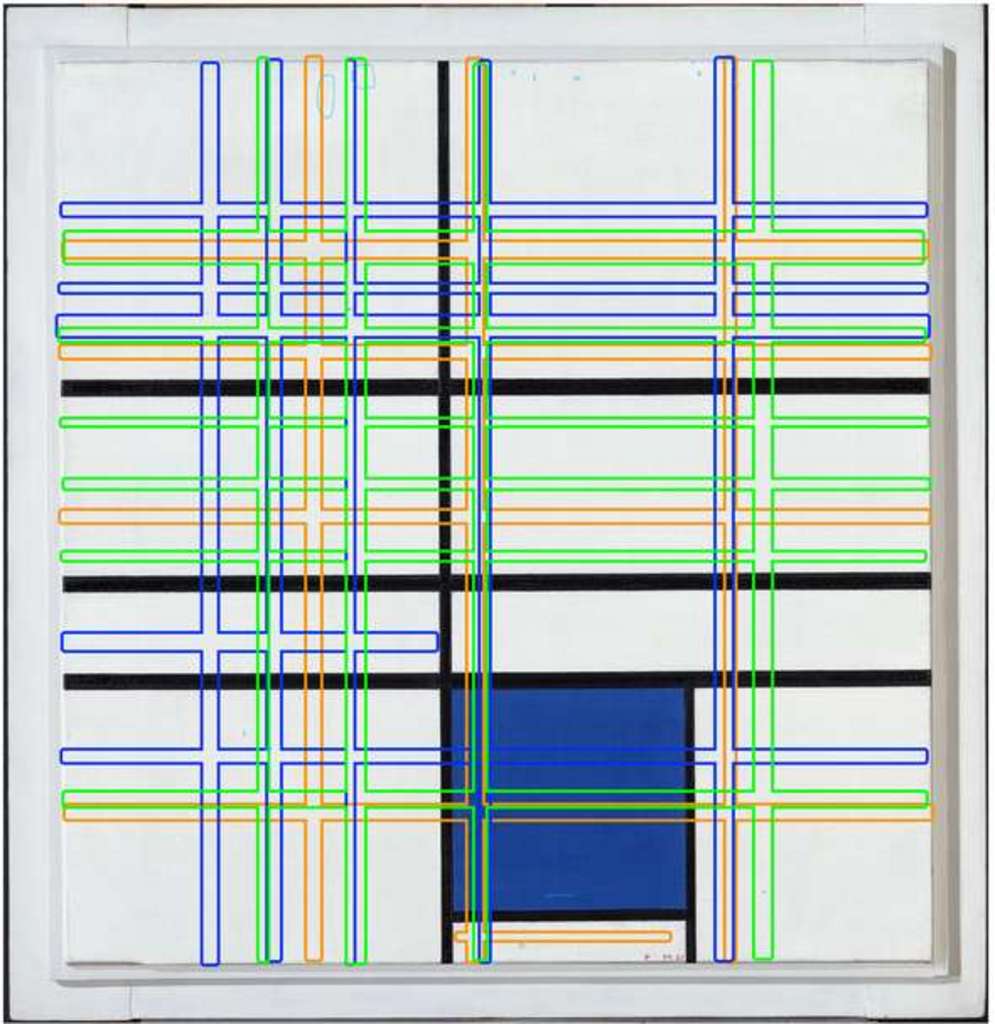
Possible lines combined:
Green: Raking light
Blue: Infrared reflectography
Orange: X-ray
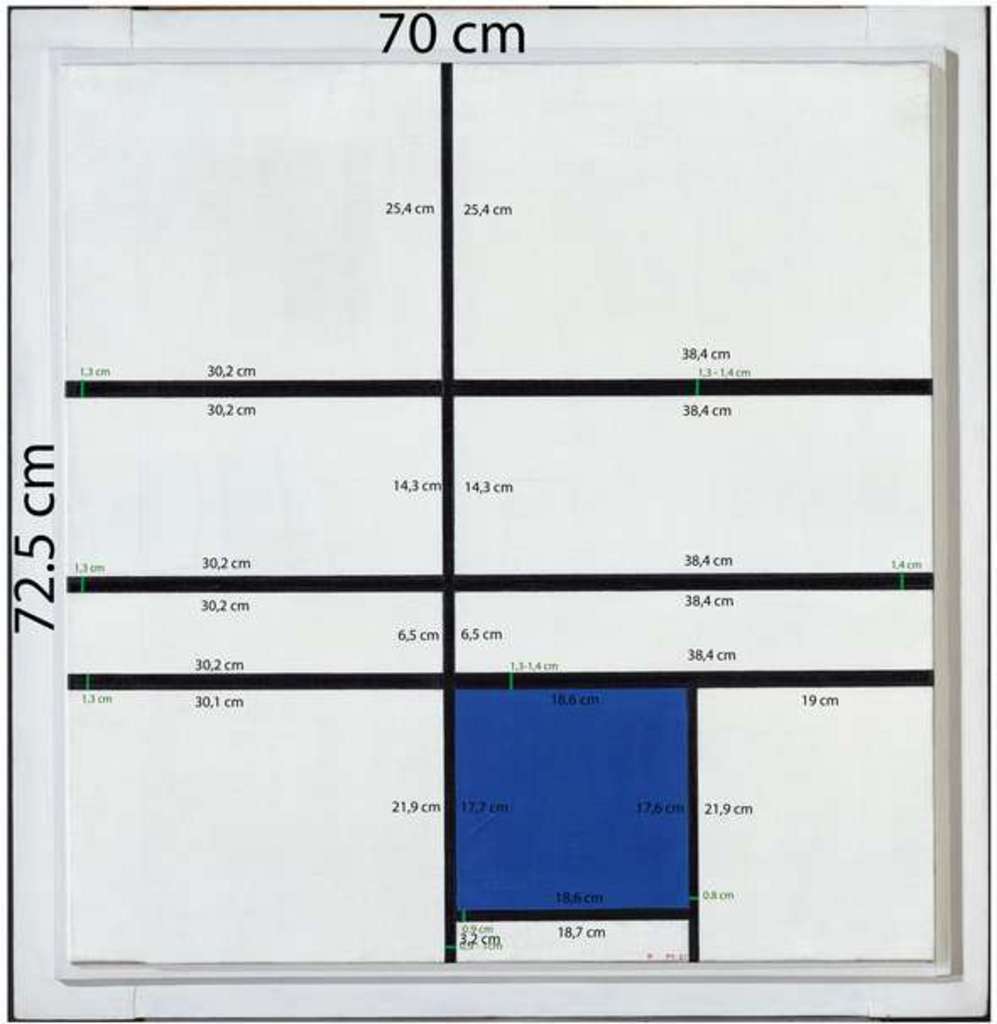
Measurement of lines and areas
The fascination of Mondrian’s working method
As we established in the case of Tableau I and Composition with Yellow and Blue, Mondrian painted Composition with Double Line and Blue, too, in several layers. It is consequently difficult to draw clear conclusions as to how Mondrian executed the individual, underlying stages of the composition. Did he use manual aids to draw the lines, or not?
In order to get a better feel for the artist and his painting process, and to test out hypotheses about his way of working, the conservation team made so-called mockups.
In the case of these mockups, we began by evaluating the existing information on Mondrian’s painting technique, and on the materials and media he employed, and studied historical photographs of Mondrian’s studio, looking for clues and evidence of implemented tools.
We furthermore experimented with various aids and accessories, ranging from the traditional wooden ruler to strips of paper and adhesive tape, such as Mondrian later used in the USA. Lines were drawn in different mixtures of black paint, using a wide variety of brushes and manual aids.
After a first interim assessment, we proceeded to more complex mockups, parts of which were painted on primed and unprimed or stretched and loose canvases. In the course of this simulation phase, the line compositions were shifted or individual lines were removed. The entire process was documented in writing and images, with the aim of shedding light on the creative and practical genesis of Mondrian’s paintings in the subsequent comparison of the mockups with the originals. This approach proved very revealing in the case of Composition with Double Line and Blue.
Sandpaper and solvents
The art-historical literature describes how Mondrian, in cases where he changed his mind about the composition of his paintings, scraped away or sanded-off the corresponding parts. The artist himself referred to this as “technical work”. Rubbing a surface with sandpaper leaves behind irregular particles and scratch marks, which can still be seen under raking light even after further paint layers have been applied on top. If an area of paint is scraped-off and then additionally ersased with solvent, paint residues can be washed onto the irregularly removed edges. The use of solvents as a way of making corrections can be observed in particular in Mondrian’s unfinished paintings.
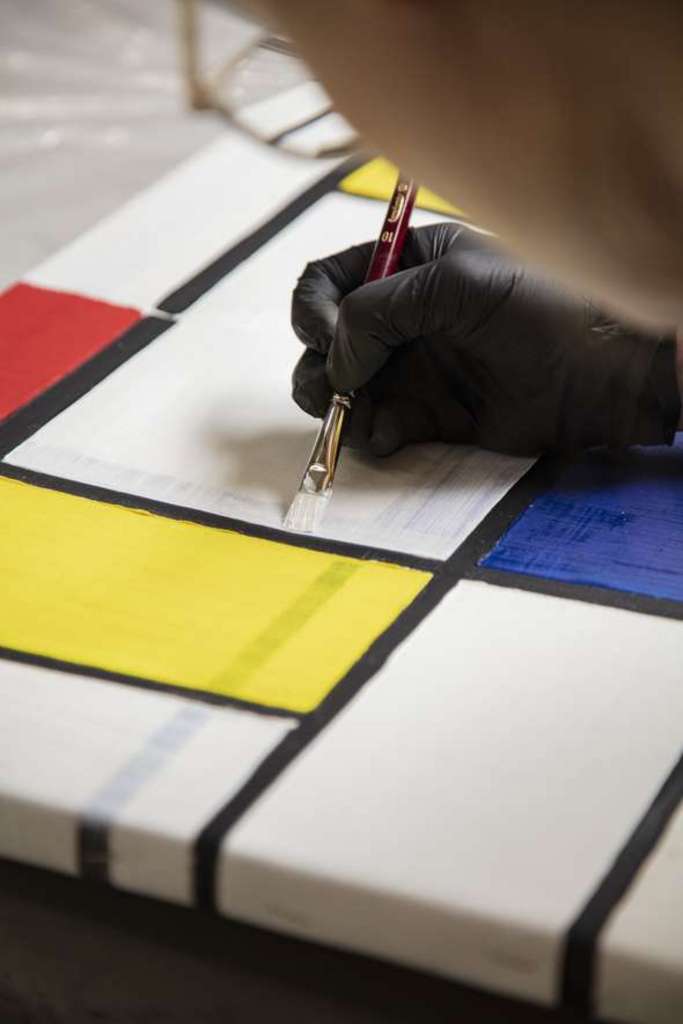
Mockups are demonstration models or simulations. They reconstruct a work of art as accurately as possible, on the basis of all the available information about an artist’s painting style and of observations made directly in front of the original. Each step of the mockup process is precisely documented, so that a visual assessment can subsequently be made of which way of working corresponds most closely to the original. Mockups are also commonly used for testing and visualizing restoration measures, before these are carried out on the original.
Where the planes meet the lines
In Composition with Double Line and Blue, the point at which the planes meet the black lines is marked by a clear division, characterized by a sort of bulge in the paint on the edge of the planes. Such a bulge can form when an aid such as a ruler is used as a stop. When using an aid that rests directly on the surface, however, there is a risk that the paint will bleed underneath it, so that the edge becomes smudged and blurred. Another artist’s aid is the malstick, along which the brush is drawn, whereby the loaded brush can likewise form a raised bulge in the paint.
It is also possible, however, to create a gentle bulge in the paint without the aid of a ruler or the like, namely by pushing the paint right up to the edge with the brush. The edges of the planes in Composition with Double Line and Blue were painted in this way, as the evaluation of our mockups has shown. In magnified view under the microscope, it can be seen how Mondrian applied the brush several times and thus forming a clear raised edge.
Even with the aid of the mockups, however, it has not yet been possible to determine whether Mondrian always used an aid when it comes to painting the black lines.
At first sight, the planes seem to be clearly separated from the lines, implying that the artist allowed lengthier drying times between the application of one layer of paint and the next. On closer inspection, however, we can see slight mixings of the lines and planes in places, indicating that the artist worked fast. Mixings of oil paint in a wet state can still be blended and are therefore not an obstacle to executing clean transitions in paint that is still wet. It is possible that Mondrian, following his prolonged illness, was under time pressure to complete Composition with Double Line and Blue. Thus we also see traces of wiping, fingerprints, and remnants of black paint, which are not noticeable at first glance, but become visible under the microscope.
Comparing mockups with original surfaces is an important way for conservators to understand what they are looking at. But even with this method, not every question can be answered.
Discover more works
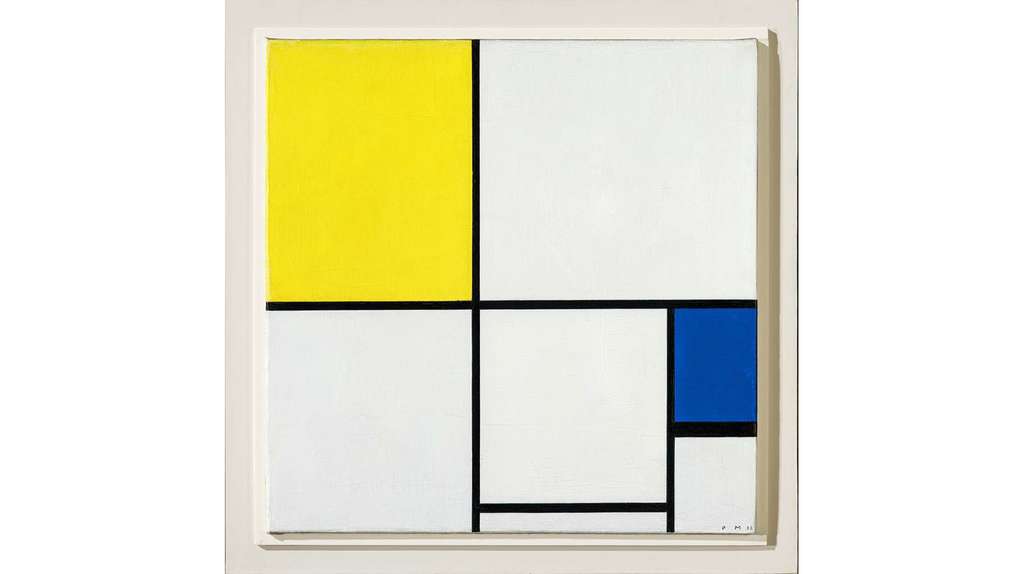
Composition with Yellow And Blue
Between 1929 and 1932, Mondrian created a series of paintings that bear a close likeness to Composition With Yellow and Blue, all of them featuring large yellow rectangles and a small blue field, this latter intended to enhance the luminosity of the yellow.
To Overview
Get an overview of the seven Mondrian works and the Piet Mondrian Conservation Project.
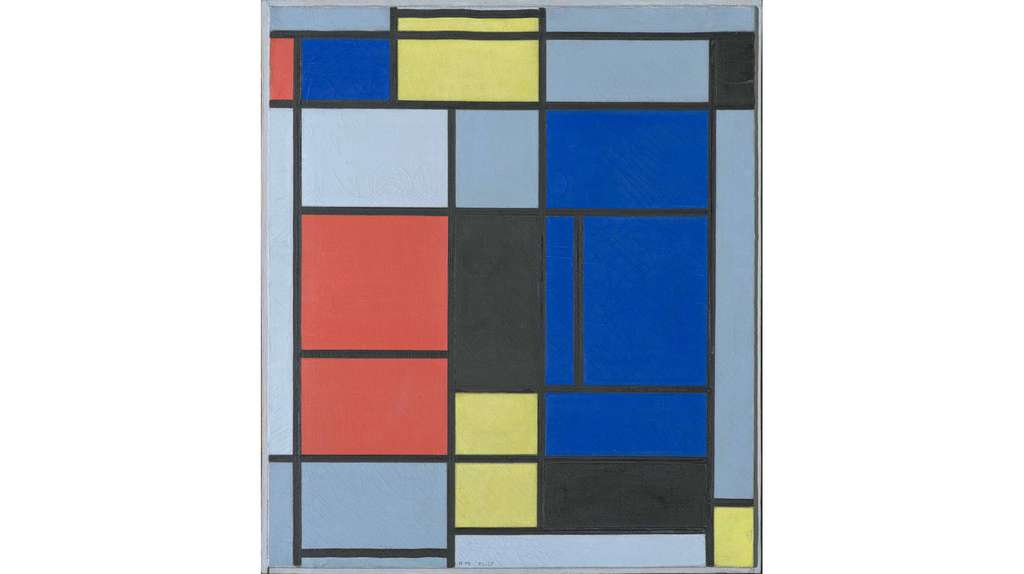
TABLEAU NO. I
Mondrian altered the painting three times and each time also considered it completed with signature and date.
